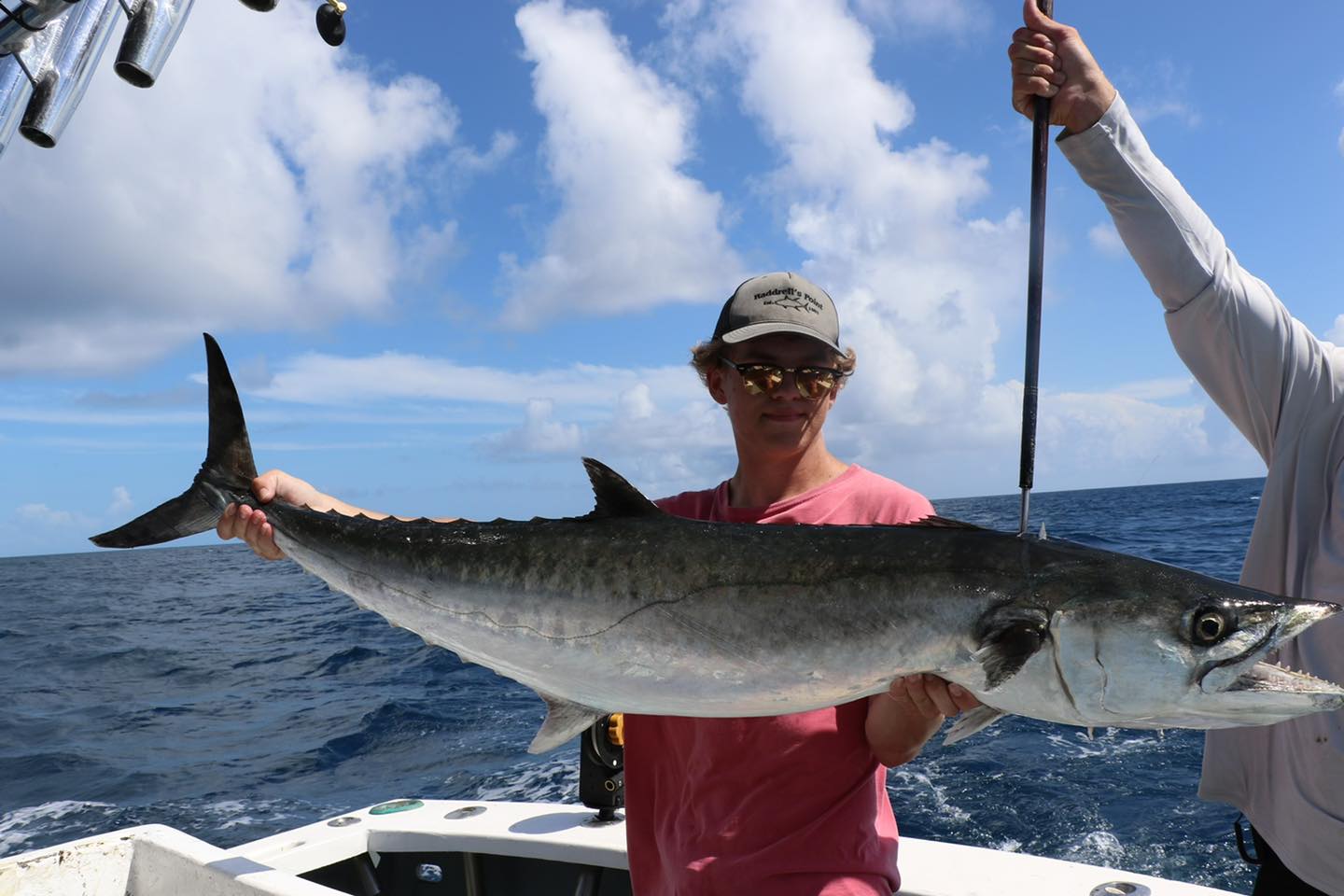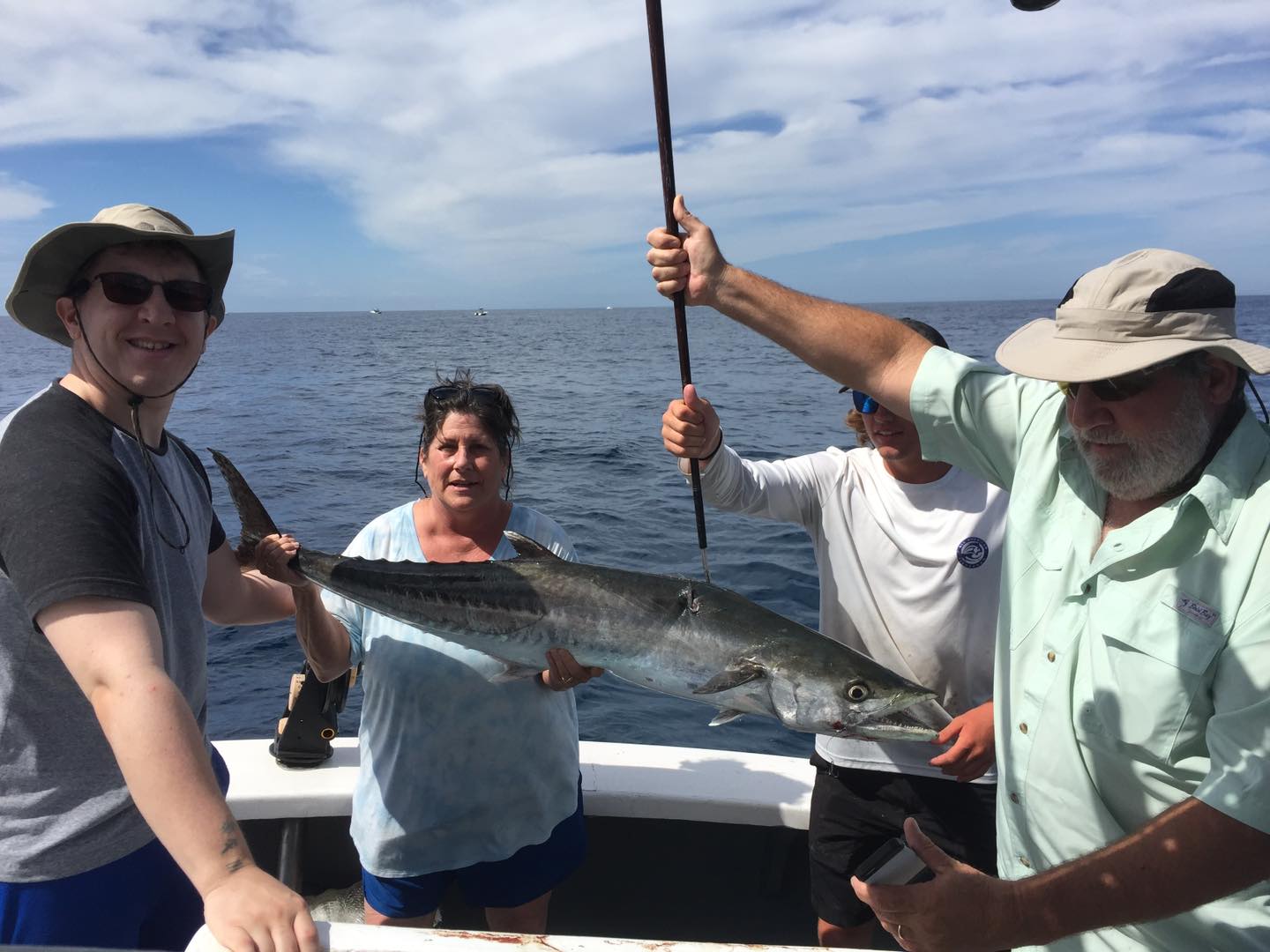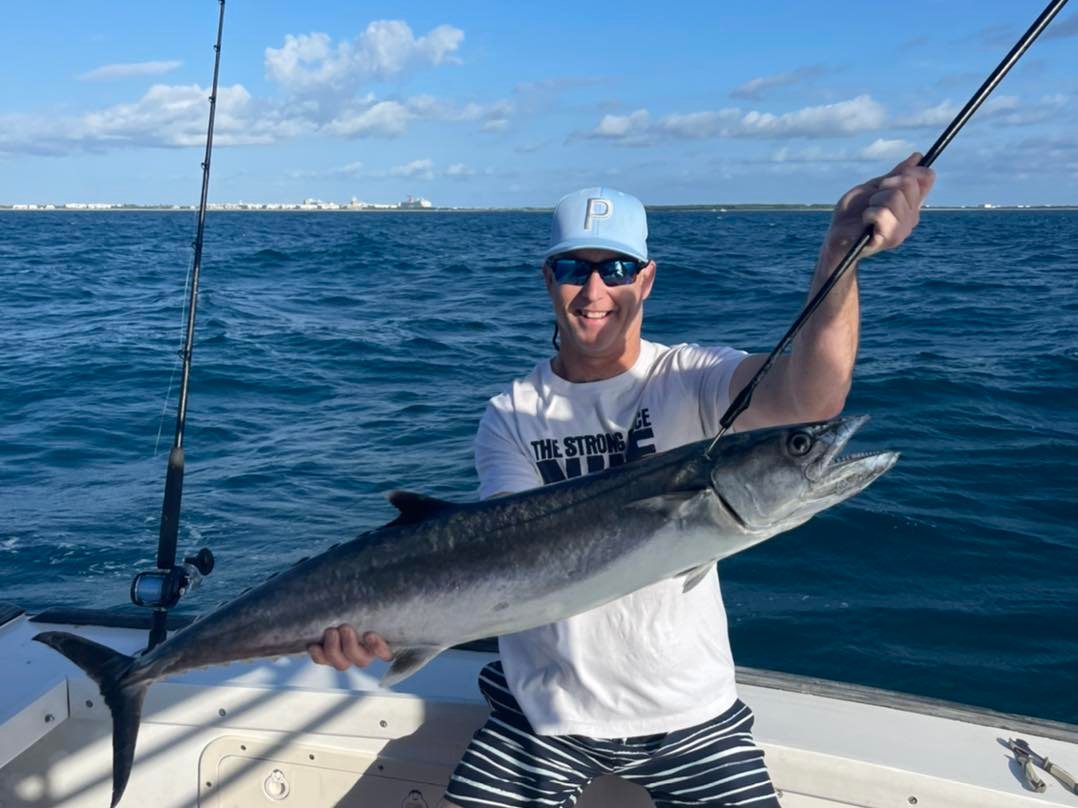Last Updated on May 6, 2025 by Eric
Cape Canaveral stands out as one of the most productive places in Florida to target king mackerel during the summer. Located along the central Atlantic coast, it offers easy access to both nearshore and offshore waters, providing consistent opportunities for fishermen looking to connect with these fast, aggressive fish. Summer marks the height of the king mackerel season in this region, when warm water, bait-rich structure, and migratory activity come together to deliver some of the best action of the year.
King mackerel, or Scomberomorus cavalla, are open-water predators with long, tapered bodies, a powerful tail, and a mouth full of sharp teeth. Their average size ranges from 10 to 30 pounds, although some fish reach 40 pounds or more. Kings are known for their blistering runs and violent strikes, especially on light tackle or when using live bait. They are often confused with Spanish mackerel or cero mackerel, but kingfish are generally larger and prefer deeper structure and faster-moving bait schools. Their feeding style relies on ambush and speed, which makes them highly reactive to well-presented baits.
This guide provides a complete breakdown of summer king mackerel fishing in Cape Canaveral, including peak conditions, locations, bait strategies, gear recommendations, and practical insights based on local patterns.
Seasonal Patterns and Conditions
Summer kingfish action begins ramping up in late May and holds strong through early fall. Water temperatures in the 74 to 84 degree range support high levels of baitfish activity, which brings schools of kings closer to the coastline. Menhaden, threadfin herring, sardines, blue runners, and cigar minnows all play a role in driving this fishery. As long as the bait stays close and water clarity remains moderate to clean, kingfish will feed actively across a wide stretch of the coast.
Early mornings are often the most productive window, especially during flat seas or light west winds. Calm days allow for better bait visibility and cleaner trolling spreads. If a cold front stalls or the wind shifts east for several days, the bite may slow or move farther offshore. Kings tend to favor water with a slight green tint and moderate current. Overly clear water sometimes pushes them deeper, while muddy water tends to shut the bite down completely.
The key factor is bait concentration. Kings are seldom found far from a reliable food source. Spotting pogie pods near the beach, suspended bait on sonar, or diving birds offshore are all strong indicators of potential kingfish activity.

Where to Fish for Summer Kings
Cape Canaveral gives fishermen access to king mackerel within a variety of depths and environments. The port itself serves as a convenient launch point, with quick access to both nearshore and mid-depth reefs.
Nearshore Waters (15 to 40 feet):
On the calmest days, especially early in the summer, kings often push into shallow water within a mile or two of the beach. Pogies regularly school up just outside the breakers, and where the bait stacks, kingfish follow. Troll or slow-drift live bait along these schools, particularly on the edges, to draw strikes from cruising kings. Popular areas include the beach stretch just south of the port, the Cocoa Beach shorelines, and waters outside Jetty Park.
Mid-Depth Reefs and Ledges (50 to 90 feet):
Once the sun climbs or the water dirties up, focus shifts to bottom structure that holds bait. Notable spots include 8A Reef, Pelican Flats, and the Southeast Shoal area. These features create vertical relief that holds sardines, hornbellies, and threadfins. Kings patrol the edges, using the structure to pin baitfish. Slow trolling along the ledges with live baits on wire stinger rigs remains one of the most consistent tactics throughout the season.
Wrecks and High Relief Areas (over 90 feet):
Later in the summer or during extended east wind periods, some of the larger kings hold deeper. Offshore wrecks that are still reachable within a 20-mile run can produce excellent fish, especially when the surface bait has thinned out. Use electronics to find the thermocline and locate suspended bait. Troll above it, or use downriggers to reach just above the deeper marks.
Bait and Presentation
Live bait is the standard for targeting kingfish during summer. The most productive options include:
-
Menhaden (pogies): Best for shallow and nearshore trolling. Cast net them off the beach or near the port.
-
Cigar minnows: Ideal for mid-depth trolling or use with a downrigger. Often available frozen at bait shops.
-
Blue runners and threadfin herring: Durable and effective around deeper structure.
When live bait is scarce or you need to cover water quickly, artificial options can also work. Drone spoons, dusters, and skirted plugs pulled at 5 to 7 knots can raise reaction bites, especially when fished behind planers to reach the right depth. However, live bait trolling between 1.5 and 3 knots is the most effective technique for drawing consistent strikes.
Rig live bait with a two-hook stinger rig. Use a short piece of wire leader with a nose hook and a trailing treble. Adjust the trailer to sit near the dorsal or just behind the bait’s tail. Use #4 or #5 wire, and connect to a 20 to 40 pound mainline via a quality swivel. Avoid excessive hardware, as kingfish can shy away from overbuilt rigs in clear water.
Downriggers, planer boards, or long flatlines can help position your bait throughout the water column. Stagger your depths until you find where the fish are holding. On calm days, some fish may strike near the surface, while others stay just above the structure line.

Tackle and Gear
King mackerel demand gear that can handle both speed and abrasion. Their teeth will cut monofilament instantly, and their long runs require smooth, high-capacity drag systems.
Recommended tackle includes:
-
Rods: 7 to 8 foot medium-heavy fast action rods
-
Reels: High-speed spinning or conventional reels with 20 to 30 pound braid or mono
-
Leaders: 20 to 40 pound wire, 6 to 12 inches long
-
Hooks: 2/0 to 4/0 live bait hooks, with #4 or #6 treble for the stinger
For artificial trolling, match your rod and reel to a 30 to 50 pound test setup, and use planers or trolling weights to achieve the correct depth. Kings are often boat shy in clear water, so longer leaders and quiet trolling motors can give you an edge in pressured areas.
Detecting the Strike and Landing the Fish
A kingfish bite is rarely subtle. Expect blistering runs immediately after the hookset, especially on live bait. Allow the fish to make its initial run without locking down the drag. Many fish are lost due to pulled hooks or broken leaders during the first surge.
Once the run slows, begin working the fish in smoothly. Avoid pumping and reeling aggressively. Kings have soft mouths and can throw the hook during erratic fights. Use steady pressure and work in a wide circle as they approach the boat. Gaff the fish cleanly behind the head, avoiding the gut area, and immediately place it on ice.
Local Regulations and Limits
As of the most recent FWC guidelines, king mackerel in Atlantic waters have the following regulations:
-
Minimum size: 24 inches fork length
-
Bag limit: 3 fish per person per day
Always verify current regulations before fishing, especially during peak summer months when updates may occur based on federal quotas or migratory trends.

Choosing a Charter Option
For those unfamiliar with Cape Canaveral waters or looking to fast-track their success, booking a local charter can make a major difference. Many experienced captains run specialized kingfish trips throughout the summer, providing everything from gear to bait to local knowledge. Charters often focus on high-percentage areas and can adjust quickly when conditions shift. Half-day trips can be enough during strong bait pushes, while full-day runs allow for access to deeper wrecks and larger fish.
Cape Canaveral offers a range of charter options catering to small private groups, families, and experienced fishermen. Many depart directly from Port Canaveral and can have lines in the water within 20 to 30 minutes.
Fish Cape Canaveral the Right Way This Summer
Cape Canaveral offers one of the most dynamic king mackerel fisheries on the East Coast, and summer is when it reaches its full potential. The mix of structure, bait concentrations, and migratory movement makes these waters ideal for serious fishing. Success often comes down to timing, experience, and knowing how to adjust when the bite shifts. That is where we come in.
At Canaveral Kings Sport Fishing, we specialize in targeting king mackerel during their peak season. Our summer trips are built around the bite, whether it is just off the beach or farther out near the reefs and ledges. We run well-equipped boats, supply high-quality tackle, and stay locked in to the daily changes that affect where and how kings are feeding. For newcomers, families, or experienced fishermen looking to chase big fish in a high-paced fishery, we provide a streamlined experience that gets you on the water and into the action quickly.
If you want to get the most out of summer king mackerel season in Cape Canaveral, book a trip with Canaveral Kings Sport Fishing. Let us handle the details while you focus on the fight.

